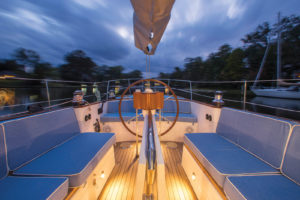What is trending on the water
New acrylic-fabric options, customer color preferences and quilted cushion covers may not be trending heavily on Twitter this week, but in shops around the country, marine fabricators are noticing a changing tide in customers’ custom preferences. Game-changing new products don’t come along every year, but the custom boat-upholstery industry is steadily affected by gradual changes in style and preference. When patterns emerge, these changes and preferences can become entire market sectors.
Color code
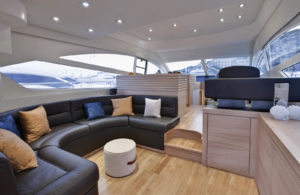
Unique color choices and custom upholstery work are increasingly in demand as boat owners strive to personalize their vessels.
Carol Racine of Racine Design, Jacksonville, Fla., has had her eye on marine upholstery trends for several decades. Lately she’s seen a move away from traditional whites to less conspicuous fabric colors.
“As far as upholstery goes, I’ve noticed a lot of customers are leaning toward off-whites and grays instead of whites, which has traditionally been the base color,” she says. “People are tired of trying to keep bright white bright white in exterior applications. It makes life a little easier, as far as cleaning your boat—you don’t have to be so particular.”
She estimates more than 40 percent of her customers want custom colors that move away from white and instead use light grays and cream colors. “I think a lot of it stems from the fact that some people don’t take quite as good care of their boat as perhaps they should, or they have a ‘mildew monster’ and they’re thinking a darker color is going to help hide it,” she explains. “I spend a lot of time educating people about how to treat their upholstery and how to keep it clean. If they don’t have a proper cover, we insist that if they do nothing else with their boat, they invest in one.”
Racine has also seen more-dramatic moves away from white. “I’ve noticed a lot of shades of brown at the boat shows this last spring. It seems to be the trend coming back, now, not quite as bad as it was in the 1970s,” she says. “We’ve been through the bright colors and taupe, and it seems to me now that the accent colors are coming back, the browns and the caramel colors for basic boats.”
One of her most memorable jobs involved no white at all. “I had a customer come in with some really wild color selections not long ago,” Racine says. “I told him it just wasn’t going to work, but he insisted on the colors he chose. When all was said and done, I have to admit that it looked pretty good.”
Quilts and covers
Yvonne Peters, owner of Custom Canvas by Yvonne in Fort Meyers, Fla., has two decades of marine fabric trend spotting under her belt. Custom vinyl cushions have recently been on her radar.
“I get a lot of requests for quilted vinyl cushions,” she says. “I get a lot of custom re-cover jobs, and many people want the quilted vinyl. It is kind of a forgiving fabric when your foam is a little bit older or beat up.”
Finding the right material can be a bit of a challenge at times because Peters hasn’t found a lot of companies that make exactly what her customers are looking for.
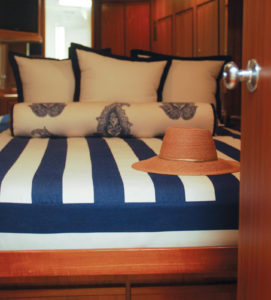
Choosing contrasting patterns in their efforts to personalize their crafts.
“There are not a whole lot of companies that make the quilted vinyl that are ribbed with channels on them,” she says. “Seabrook, Seaquest or Nautilex make some of them, but I end up having to do quite a bit of searching when I’m working on a custom quilted cushion job, because not every vinyl comes quilted.”
Taking the time to source and select superior cushion material has served Peters well, as more of her customers are selecting quilted vinyl for their cushions. She points out making cushions that last and hold up against the elements can be a difficult project for marine fabricators. “To make a regular cushion is difficult enough,” she says. “With a boat cushion, there is so much more that can go wrong: body oils, discoloration from ice bags, water, mold stains, etc. You cannot get all of that off no matter how hard you try.”
Peters and her customers have discovered quilted vinyl makes some of the nicest cushions. “The quilting is done with what looks like a heat-sealed seam,” she says. “A heat-sealed channel is made down the entire roll, and then they fill it with Dacron or a similar material, process it and roll a pleat in it. It works very nicely and makes a better cushion than flat vinyl.”
She has also been sourcing new textiles for window covers. Improvements in visibility and UV protection have created several new options for window covers, she points out.
“There are some nice [window cover] fabrics out there,” Peters says. “I really like the Stamoid window-cover fabric I did a really nice window cover project recently, and I used Stamoid Solstice. It was perfect, it has great visibility, and blocks something like 90 percent of UV rays. People can still see out the windows and their boat doesn’t feel like a cave.”
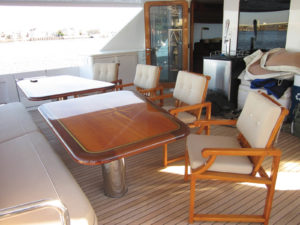
Everything from body oils to mold stains add to the challenges of making attractive boat cushions.
Emmie Swanson, owner of Salty Stitches LLC in Valdez, Alaska, has seen a unique trend in winter boat covers. Winter boat covers in Alaska must be able to face the harshest winter weather conditions. Swanson points out that many of the best textiles for winter covers are very expensive to ship to Alaska. “I love making [winter covers] out of Stamoid if I can, but getting things here is really expensive,” she says. “Many of my customers will actually bring me an industrial tarp, and I will fabricate a cover out of that.”
The trend has created some other unique marine fabrication techniques, as well. “The fabrication has to be different here because of the snow load,” she says. “I just did a 38-foot sailboat on which we put an additional boom three feet above the regular boom and used the spinnaker pole, like a traditional winter cover, but now it has a much higher pitch. The tarp material is naturally slippery, as well. Combined with the steeper pitch, the covers help more snow to slide off.”
Inside and out
Afton Marina and Yacht Club of Afton, Minn., sees its share of new custom marine upholstery requests, as well. The company has a custom canvas department staffed by two Master Fabric Craftsmen. Greg Smith is one of them. The custom work they do ranges from bimini tops to cushion covers.
“We do a lot of custom tops, full enclosures and covers,” Smith says. “We also have a lot of interior work we are doing that is moving away from traditional vinyl and fabric. A lot of people are having us install Ultraleather in place of other [upholstery coverings].”
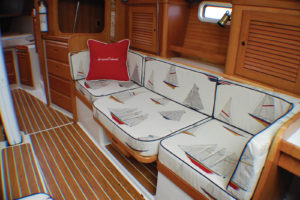
In addition to traditional vinyls and fabrics, fabricators report that boat owners are requesting Ultraleather as an increasingly popular option for custom interiors.
Ultraleather is a 100 percent polyurethane surface fabric with 100 percent reinforced rayon backing. The textile has the look and feel of leather thanks to the Takumi technology used to manufacture it. Durability, ease of care and thermal comfort make Ultraleather a luxury item that is becoming popular in many interior marine upholstery applications. In addition to the luxury look and feel, Ultraleather also provides a stain-resistant protective surface for marine furniture, Microfoam cushioning and a dimensionally stable substrate.
Smith is currently working on an interior reupholstering project for a client who wants to replace an existing couch covering with Ultraleather. “They like the look of it, and many people think Ultraleather feels nicer than regular vinyl,” Smith says. “I’ve seen it used on a lot of furniture in boats.”
Jay Hanks, owner of Allerton Harbor Canvas in Hull, Mass., has also seen a trend toward Ultraleather and other faux-leather vinyl fabrics.
“I recently [reupholstered] an entire boat, including all of the cushions below deck,” Hanks says. “The customer wanted his boat to look like the new Catalinas, and his was about five years old. There was nothing wrong with his cushions, but he wanted to upgrade the look with Ultraleather. When I did the estimate, I included the cost of material and labor for every single cushion. The bid came in at over $10,000. I was skeptical that he would want to go forward with it, but sure enough he did.”
Hanks has seen other faux-leather vinyl products become more popular, as well. He attributes it to the luxury feel, as well as the ease of care. “Most of the vinyls coming out now are cleanable and don’t stain,” Hanks explains. “You can wipe up just about anything on them.”
Smith says he hasn’t seen a lot of change in requests for material on custom exterior jobs, although he has noticed a slight trend toward all acrylic fabrics. “We do a lot of custom designs [for exterior] enclosures and tops for 30-foot
to 65-foot boats, and our customers usually want us to use acrylics for them,” he says.
“We use Sunbrella and Stamoid products more than anything.”

The selection of acrylic fabrics, both in texture and color, has increased dramatically in the past decade, and customers are almost overhelmed by the choices.
Racine agrees. “I’ve definitely been using more acrylics over the years. The trend hasn’t necessarily come directly from customer requests, but because companies like Glen Raven and Outdura have really stepped up as far as broadening their furniture fabric lines,” she says. “I primarily have [acrylic fabrics] in my showroom now. I don’t really carry other types because we are strictly a marine shop. I do have a few polyesters if someone wants more of a plush or velour, but when customers ask me my opinion, I generally direct them to acrylic fabrics.”
She points out that the selection of acrylic fabrics, both in texture and color, has increased dramatically in the past decade. “There is such a selection now that sometimes it is almost overwhelming to customers,” she says. “I have to refrain from dragging all the sample books out. Now I talk to them, get an idea of what they are looking for, and then I’ll select samples based on what they’ve told me.”
Swanson has seen her customers choose more weather-resistant fabrics in recent years. Because of the extreme cold, rain and snow in her climate, many mainstream fabrics don’t cut the mustard.
“Most of my customers are interested in the weatherability of their fabric,” she says. “Will it get stiff and crack when it gets cold? Can it handle a heavy snow load? When it rains here, it rains and rains.”
To solve the problem, Swanson relies more heavily on Top Gun marine fabrics. “I like Sunbrella, and will use it for my customers who mainly use their boats in the summertime,” Swanson says, “but Top Gun fabrics are what I have been using to stand up against lots of water and snow.”
Price check
Hanks has noticed another trend, as well: the effect of Internet price checking on his fabric markups. Customers now have nearly instant access to online fabric wholesalers and distributors, including websites that sell secondhand and discount materials.
“It’s changing the way I function and deal with buying materials and reselling them,” Hanks says. “Back in the day, I could get a decent markup on some of the fabrics I was using. Wholesale prices gave me some room, but now, because of the Internet, there are places that are actually selling materials for less than what we pay to our normal vendors.”
While Hanks says he still gets wholesale pricing from his vendors, he says those prices have gone up. Combined with less freedom to mark up, the change is cutting into the profit margins of marine fabricators across the country.
“The trend is to have less markup on materials,” he says. Whether the customer is price checking, or if they need to know for an insurance quote, or if they see something on the Internet, it is affecting the money we make on projects.”
Hanks has even had customers bring in their own fabric for projects in order to save money. “I don’t encourage it, and actually have a surcharge for bringing your own fabric,” Hanks says. “Sometimes I’ll have to buy more to finish the job, sometimes it requires different handling, and sometimes it’s just the wrong kind of material, and that cuts into dollars and cents and time on our end.”
He says the same is true with marine foam. “The general impression many customers have is that we’re marking up stuff or selling it for way over what they could get it over the Internet, so we’re competing against sometimes legit and sometimes non-legit sources on price,” Hanks says. “The price of fabric, foam and other materials is getting more expensive. That isn’t going to change. What’s changing is the way we sell those materials to customers who want the best deal they can get.”
Changes in preferences can pose a challenge to marine fabricators. With the emergence of new trends comes the need to adapt and change with the customer climate. Moving outdated inventory and finding new sources to meet customers’ needs aren’t always easy things to deal with, but Racine welcomes her customers’ requests.
“Sometimes the customer is right!” she says.
Jake Kulju is a freelance writer from Minneapolis, Minn.
 TEXTILES.ORG
TEXTILES.ORG 


